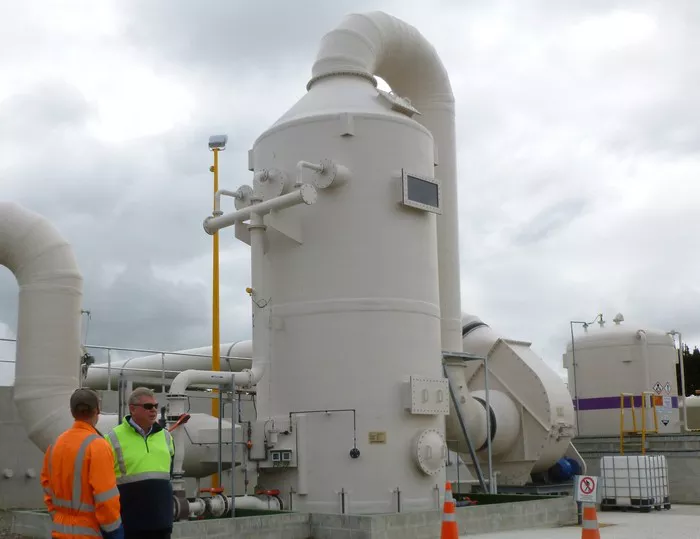Air pollution is a significant concern globally, impacting both indoor and outdoor environments. Indoor air quality, in particular, is crucial for human health and comfort, especially considering that people spend the majority of their time indoors. To address this issue, various technologies have been developed, among which air scrubbers stand out as effective tools for air purification.
Working Principle:
Air scrubbers function by utilizing different mechanisms to remove contaminants from the air. The primary methods employed include moisture, cooling, and filtration. These mechanisms work together to capture particles, gases, and odors, resulting in cleaner air.
Moisture-based air scrubbers utilize water to trap particles and pollutants. As air passes through the scrubber, it comes into contact with water, which captures dust, smoke, and other airborne particles. Additionally, moisture-based scrubbers can help to humidify dry air, improving overall air quality and comfort.
Cooling-based air scrubbers, on the other hand, rely on temperature differentials to remove pollutants. By cooling the air, these scrubbers cause particles to condense and become easier to capture. This method is particularly effective for removing volatile organic compounds (VOCs) and other gaseous pollutants.
Another common type of air scrubber is the filtration-based scrubber, which employs various filters to capture contaminants. These filters can include pre-filters, HEPA filters, and activated carbon filters, each designed to target specific types of pollutants. Filtration-based scrubbers are versatile and can effectively remove particles, allergens, and odors from the air.
Types of Air Scrubbers:
Air scrubbers can be categorized into two main types: wet and dry scrubbers. Wet scrubbers use water or other liquids to capture pollutants, while dry scrubbers rely on filtration or other dry methods.
Wet scrubbers are particularly effective for removing large particles and gases from the air. They work by passing contaminated air through a water stream, where pollutants are absorbed and neutralized. Wet scrubbers are commonly used in industrial settings to control emissions from processes such as manufacturing and combustion.
Dry scrubbers, on the other hand, utilize dry materials such as filters or sorbents to capture pollutants. These scrubbers are often preferred in applications where water usage is restricted or where moisture may cause issues, such as in sensitive electronic environments or cleanrooms.
Benefits:
The use of air scrubbers offers several advantages for both industrial and residential applications. Some of the key benefits include:
1. Improved Air Quality: Air scrubbers effectively remove pollutants, allergens, and odors from the air, resulting in cleaner and healthier indoor environments.
2. Odor Control: By capturing and neutralizing odorous compounds, air scrubbers help to eliminate unpleasant smells, creating a more comfortable living or working space.
3. Fresh Air Supply: Air scrubbers can supply fresh, clean air to indoor spaces, reducing the risk of respiratory issues and promoting overall well-being.
4. Environmental Protection: By removing harmful pollutants from the air, air scrubbers contribute to environmental protection efforts, mitigating the impact of air pollution on ecosystems and human health.
Stages of Filtration:
The air scrubbing process typically involves multiple stages of filtration to ensure thorough removal of contaminants. These stages may include:
1. Pre-filtration: Pre-filtration is the first stage of the scrubbing process, where large particles and debris are captured before they can reach the main filtration system. This helps to extend the lifespan of the filters and improve overall efficiency.
2. HEPA Filtration: High-efficiency particulate air (HEPA) filtration is a crucial step in the air scrubbing process, where fine particles and allergens are captured by dense filter media. HEPA filters can remove up to 99.97% of particles as small as 0.3 microns, making them highly effective for improving indoor air quality.
3. Activated Carbon Filtration: Some air scrubbers may also include activated carbon filters, which are capable of adsorbing gases, odors, and volatile organic compounds (VOCs). Activated carbon is a porous material with a large surface area, allowing it to trap and neutralize a wide range of airborne pollutants.
Use Cases:
Air scrubbers find applications in various industries and environments, including:
1. Industrial Settings: Air scrubbers are commonly used in industrial facilities to control emissions, remove contaminants from process air streams, and improve indoor air quality for workers.
2. Construction Sites: Construction sites often utilize air scrubbers to control dust and particulate matter generated during demolition, sanding, and other activities, ensuring compliance with environmental regulations and promoting worker safety.
3. Healthcare Facilities: Hospitals and healthcare facilities rely on air scrubbers to maintain sterile environments, control airborne pathogens, and prevent the spread of infections.
4. Residential Buildings: Air scrubbers are increasingly being used in residential buildings to improve indoor air quality, remove allergens, and create healthier living spaces for occupants.
Maintenance and Care:
Proper maintenance is essential to ensure the optimal performance and longevity of air scrubbers. Some key maintenance tasks include:
1. Regular Filter Replacement: Filters should be replaced according to the manufacturer’s recommendations to prevent clogging and maintain efficient operation.
2. Cleaning: Air scrubbers should be regularly cleaned to remove accumulated dust, debris, and microbial growth. This helps to prevent contamination and maintain air quality.
3. Inspection: Periodic inspection of air scrubber components, including fans, motors, and seals, can help to identify and address any issues before they escalate.
4. Calibration: If applicable, air scrubbers should be calibrated periodically to ensure accurate operation and compliance with regulatory standards.
Conclusion
Air scrubbers play a vital role in air purification by effectively removing contaminants, odors, and allergens from indoor environments. By understanding their working principle, types, benefits, filtration stages, use cases, and maintenance requirements, users can make informed decisions about implementing air scrubbing solutions to improve air quality and promote health and well-being.

